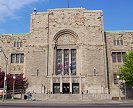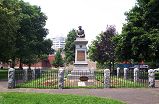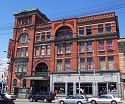Located on Queen’s Park at Bloor Street, the Royal Ontario Museum (ROM) was opened in 1914. It was originally created to house the then scattered collection of museum material held by the University of Toronto. The building was designed by Toronto architects Darling and Pearson. The 1914 wing of the museum is to the west of, and parallel to, the building pictured here. This wing, which fronts on Queen’s Park, opened in 1933 and was designed by architect Alfred Chapman. The museum today holds nearly six million objects of the cultural and natural history of Canada and the world. It ceased to be a part of the University of Toronto in the mid-1960’s. As of May, 2003, construction has begun on the new addition to the museum, called “Renaissance ROM”. “Through the restoration of the original architecture and the construction of a new signature building, Renaissance ROM will create a spectacular new environment for exhibits and galleries.” (from ROM website)
Located in a small parkette bounded by Niagara, Portland and Wellington Streets is the Old Garrison Burying Ground. The historical plaque reads as follows: “The Old Garrison Burying Ground 1794-1863. The Town of York’s first burying ground lies within this park. Established by the British Army, the cemetery occupies a 38 by 91 metre rectangle running at a diagonal across the centre of the park. The first known interment was that of Katherine Simcoe, the fifteen-month-old daughter of Lieutenant-Governor John Graves Simcoe and his wife Elizabeth. Many of the known burials were the wives and children of garrison soldiers. Notable interments include Christopher Robinson (d. 1798), father of Sir John Beverly Robinson; Captain Neal McNeale, killed in the Battle of York on 27 April, 1813; and Lieutenant Zachariah Mudge (d. 1831), private secretary to Sir John Colborne, whose unexplained suicide shook the Colonial community. The last known burial was that of Private James McQuarrick (d. 1863). Afterwards, an interim military cemetery opened at the foot of Dufferin Street, which was replaced with one on Garrison Common to the west of Fort York.” A few of the original grave markers are cemented lying flat, beneath the statue in this picture.
Located on Queen Street West in Parkdale, the Gladstone Hotel has been a fixture in the area for over a century. The historical plaque reads: “Named after British Prime Minister Wm. E. Gladstone, this 60 room hotel was built in 1889 adjacent to the Parkdale train stations. The original owner, Mrs. Susanna Robinson, had been left a widow with 13 children. It was designed in a decorative Romanesque style by G.M. Miller, a distinguished Toronto architect. Its three-storey steeple dominated the skyline until the 1940’s. Accredited by the Royal Winter Fair, it was considered “the only safe place for one’s Great Aunt to stay alone.” It was originally used mostly by commercial travellers based in the heavy industry in the area. The building was restored by the Appelby family in 1989 in memory of their late father.”
This building is located on Adelaide Street at George, beside Toronto’s First Post Office. De La Salle Institute was Catholic boys’ school started by the De La Salle Brothers in about 1851. They first located at Jarvis and Lombard, and moved to this building in 1871, after the Bank of Upper Canada folded and vacated the adjacent premises. The school remained at this location until 1913 when they moved to Bond Street, beside St. Michael’s Cathedral. In 1931 they moved again to a property near St. Clair and Avenue Road, their present location.
No. 8 Hose Station, located at the corner of College St. and Bellevue Avenue, was originally built in 1877-78. Its construction was part of an expansion of Toronto Fire services during the 1870’s, when it became a full-time department staffed by paid firefighters rather than volunteers. In 1911 No. 8 was the first station to get a new motorized fire engine, eventually replacing the horse-drawn engines. This station has had several additions and alterations over the years, and was completely rebuilt in the original style after a fire occurred in 1972.
The International Order of Odd Fellows (I.O.O.F.) was one of several “secret societies” of men prevalent in the 19th century. The order’s origins go back to 1745 or earlier in England, the first recorded instance of the meeting of an Odd Fellow Lodge. Their purpose and aim was that of mutual aid and benevolence, helping out each other and less fortunate members of society. The building pictured here, located on the north-west corner of College and Yonge Streets, dates from 1891. It was designed by Toronto architects Norman Dick and Frank Wickson and resembles a small medieval castle. For many years Lodge 49 of the I.O.O.F. held their secret, mystical meetings on the upper floors of the building, while the Canadian Imperial Bank of Commerce (CIBC) occupied the main floor. A number of years ago the CIBC moved out and the main floor is now occupied by Starbuck’s. The upper floors are rented out to various businesses. The I.O.O.F. is still in existence today, with nearly 5,000 lodges worldwide.



